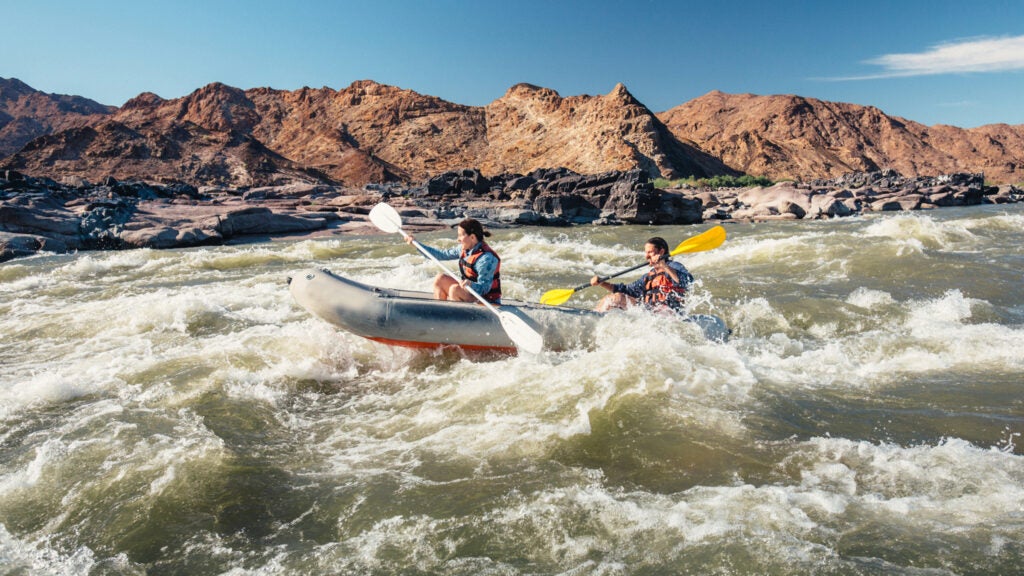No products in the cart.
Outdoor Adventure
The Best Canoes, Kayaks, and Rafts (2024)
From lightweight packrafts that weigh less than some tents to whitewater rigs that can take on the gnarliest rapids, there are hundreds of different types of boats on the market these days. Last year, we tested canoes, kayaks, rafts, and everything in between from Colorado’s rivers to Florida’s estuaries. Below, you’ll find a sampling of some of the best paddle craft for hitting the water in 2024.
Be sure to check out our favorite board shorts and women’s swimsuits as well.
At a Glance
All gear in this guide was tested by multiple reviewers. If you buy through our links, we may earn an affiliate commission. This supports our mission to get more people active and outside. Learn more.
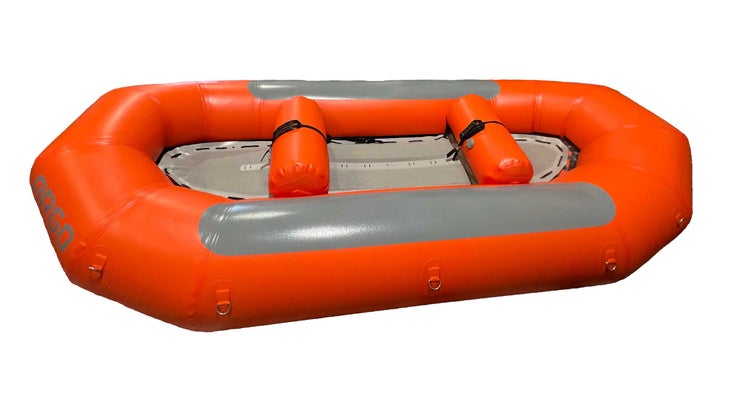
Best Raft
Sotar Rogue Argo
Length: 12 ft
Exterior Width: 68 in
Tube Diameter: 21 to 17 in
Air Chambers: 4 (including thwarts)
Capacity: 675 lbs
Weight: 60 lbs
Pros and Cons
⊕ Nimble enough to get through creeks while also big enough for the biggest rapids
⊕ Diminishing tubes makes it extremely responsive
⊗ The guide position is hard to get used to if you have three people paddling
Taking advantage of the growing small inflatable market, Sotar set out to make the ultimate R2/R3 raft (which means it can carry two or three paddlers) and came up with its new Rogue Argo, a 12-footer that paddles like a paddle cat but has a floor like a raft. The result is a craft that’s small and nimble enough to charge creeks while beefy enough to run meaty Class IV-V rapids, like on the Gauley River in West Virginia. Diminishing tubes in the front (but not the stern), two thwarts, and a weight of only 60 pounds—lighter than some of the 10-footers on the market—are just a few of the features that had our testers sold. It’s so light that it turns your strokes into speed when you need it most and lets you cartop or shoulder-carry it single-handedly. All these features make for a craft that dishes up the same fun as a paddle cat but with a raft’s space and buoyancy.
That said, don’t assume the Rogue Argo is just a shrunken-down expedition raft. The durable RF-welded urethane construction and new design features are built specifically for the category. Perhaps the raft’s most noticeable feature is its diminishing tubes, whose diameters are smaller up front and larger in the stern (17 inches to 21 inches). “It creates additional rocker which lets you go up and over oncoming features while keeping the back buoyant,” said tester Aaron Ball, a Swiftwater Rescue instructor for Colorado’s Southwest Rescue. “It was super responsive for two people, tracked well, and took hits with ease. The Reverse Mullet might have been a better name for it.”
A mesh floor keeps the weight down while draining water quickly, maintaining buoyancy. While water can enter it in wave trains, it sits up high and out of the water most of the time thanks to cam straps securing the mash to the thwarts. It also drains fast—our testers on Colorado’s Animas River found it dryer than expected. “Its mesh was great—it didn’t let much water through and made the boat lighter for an already small craft,” Ball said. His only concern: “With frigid water temps, it could lead to cold feet.”
The two thwarts and grab handles were ideal for holding on when the going got rough. The thwart spacing is adjustable, which made it easier for testers to lock their feet in. “It’s nice that two thwarts are included,” said tester and former international guide Miles DeFeyter. “A lot of rafts don’t have that. And the grab handles are awesome—I held onto them several times—this thing was made to run the gnar.”
The only knock? Paddling it as an R3. “The guide position takes a little getting used to,” added Ball. “Sitting on top of the 21-inch tube feels a bit different than the standard 19-inch of a classic raft. It takes a while to figure out what position feels most comfortable to guide from.”
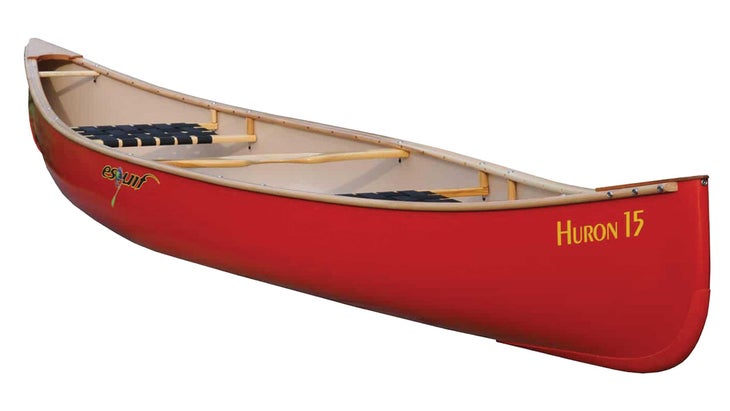
Best Canoe
Esquif Huron 15
Length: 15 ft.
Width: 35 in.
Weight: 55 lbs.
Pros and Cons
⊕ Durable material so it doesn’t get dings easily
⊗ Can’t be loaded with too much gear, or it becomes sluggish
It’s rare for a new canoe to hit the shelves, but Esquif’s new Huron 15 impressed testers enough last fall to make this year’s cut. It can be paddled solo or in tandem and has a hull based on its popular Prospector design, but trimmed slightly lower from 14.5 inches to 12.5 inches—making it more sporty and less susceptible to wind. It’s designed for cottagers and recreational paddlers who want a solid canoe for calm water and small rivers but don’t need the depth and capacity of the Prospector.
Tester Nick Hinds took it out with his son, Finn, on Washington’s Cottage Lake, putting it through its paces on a quiet morning with glassy water and moody skis. “I could load it by myself—which is hard with most canoes—and I could paddle it solo or with my son,” he said, calling it agile and forgiving. “It seemed like the hull knew where I wanted it to go.” Hinds also prized its efficiency. “Each stroke was felt instantly,” he said. “It carved turns right when needed and tracked when we needed to go straight. And while limiting its use on whitewater, its low sidewall prevents it from being blown off course.”
The only drawback Hind noted was its carrying capacity. “Perfect for mild moving water—as long as it’s not loaded too heavily,” he said, explaining that it was best for two lighter people or one heavy person, and not too much gear. As for outfitting, the webbing seats “were comfortable” and the ash yoke “formed well for one-person carrying.”
Tester Alan Schmidt, who owns eight canoes and has been paddling for 40 years, put it through its paces on Washington’s low-water Class I-II Skykomish with not a child, but his 80-pound Labrador, who had no trouble centering his weight. Schmidt said that despite the Esquif 15’s rock and log dodging, the canoe tracked well, requiring “minimal correction strokes,” and was responsive to sharp turns. He also appreciated the seat height and tumblehome (the inward curve of the hull above the waterline), which “allows for easy and efficient solo paddling.”
Best of all, testers don’t need to worry about dings. It’s made from T-Formex a layered plastic with flotation and abrasion resistance, which has supplanted Royalex. Schmidt loved the material, especially on the unavoidable submerged rocks. “It slid over them easily instead of sticking, as some composite materials do.”
Still, Schmift did manage to flip the Esquif 15 in the tight confines of the canyon, putting him and his dog into the drink. Luckily, they had no trouble getting back in. “The recovery was simple and easy due to the positive buoyancy and the handles on each end,” he said.
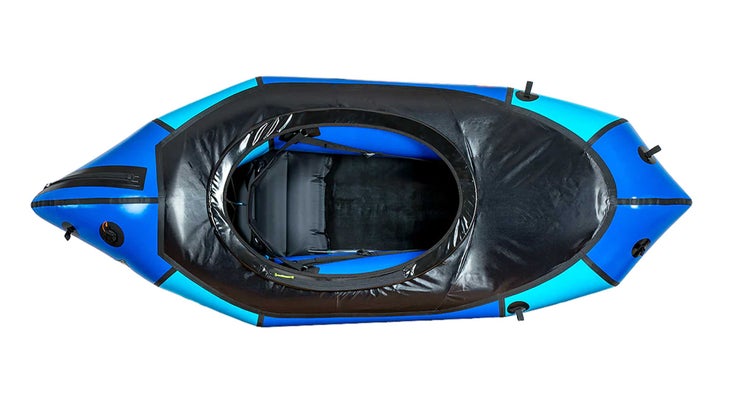
Best Pack Raft
Alpacka Refuge
Length: 87 in. (medium)
Width: 34.5 in. (medium)
Weight: 6.7 lbs (medium)
Pros and Cons
⊕ Super lightweight but very river-worthy as well
⊕ Re-rigging time takes just five minutes
⊗ Might replace all your other rafts
Devotees of uber-lightweight backcountry craft with whitewater chops, rejoice: Alpacka’s new 2024 Refuge will have you re-thinking where you can paddle, whether you’re shouldering it to a high-alpine fishing lake, accessing remote rivers, or even bikepacking with it as part of your shuttle.
This packraft combines features of its earlier Refuge and whitewater version into one model, checking all the boxes for exploring wilderness waterways. Already known for its material’s bombproofness, Alpacka upgraded the new version to a beefier 840-denier nylon, along with a 210-denier high-count nylon hull. Now available in medium (7 feet 3 inches long) and large models (7 and a half feet and 5 inches long), it also comes standard with a backband, inflatable whitewater foot brace, and two-point thigh straps to hold you in when the going gets rough.
We tested it on the rivers and lakes of Northwest Colorado, assessing its whitewater mettle and its packability. First off, the weight comes to just 6.7 pounds for the medium (barely more than a three-person tent), making it easy to carry. It’s also fit onto the outside of our daypack easily, with plenty of weight to spare for beer, bread, and Brie. After carrying it into Jonah, Whale, and Martha lakes, we were also impressed with its game-changing cargo fly and airtight zipper that lets you stash gear inside the tubes, keeping it out of the way and your center of gravity low for added stability. “You just have to make sure you load it evenly so it’s not lopsided,” said one tester. Deflating it between lakes, we had the re-rigging time down to just five minutes. Simply roll it out, insert the nozzle of the micro-weight bellows bag, fill ‘er up with a pump, and top it off by blowing.
Another tester took it on the nearby Class II+ Colorado River, sussing out its whitewater cred by assessing the thigh straps, backband, footbrace, and sprayskirt, which attaches to a PVC rim. In the Eye of the Needle rapid, it slipped into the scouting eddy effortlessly and easily punched through the wave train. “It rode up and over the waves like a raft,” he said. “And the skirt kept all the splashes out.” The beefier floor shrugged off all abrasions, including a bottom-dragging landing.
Tester Dan Ransom, a 6’1” packrafter who paddles 60 days a year, took it out on Oregon’s Class II-III Rogue River and appreciated its river worthiness and roominess. “The whitewater rigging makes it a super capable boat for the size and weight,” he said, adding it packs down smaller than comparable whitewater models. “I was impressed by how stable, fast, and nimble it is. A fun little playboat for go-karting around on rivers with easier features. And it’s the easiest-rolling boat Alpacka makes.” Its biggest strength: “A capable boat that’s very light when it’s on your back. Ideal for trips that require a lengthy approach or exit, moderate whitewater, and where weight is at a premium.”
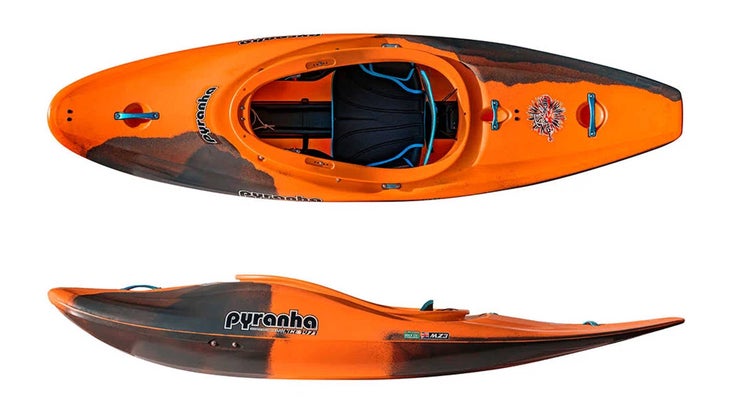
Best Whitewater Kayak
Pyranha Firecracker
Length: 7’11”
Width: 26 in
Weight: 41 lbs
Pros and Cons
⊕ Great for every skill level
⊕ Higher knee placement provides comfortable paddling position
⊗ None
Pyranha’s new Firecracker is plain, well…explosive. With its volume loaded up front for river running and a slicey stern for more playful paddles, the new half-slice lets you whip into micro eddies, snap onto waves, and get vertical wherever you want, all while retaining river runnability, Our testers put it to the task on various sections of Washington’s Skykomish River and the East Coast’s Nolichucky River, and found it extremely capable in both settings.
Whether you’re a pro or an average Joe, you’ll be comfortable running rapids on the Firecracker. The boat’s planing hull keeps it stable, spinnable, and surfable, while its rockered but short bow keeps you dry and relaxed. “A nice balance of playfulness and forgiveness,” said 145-pound tester Judah Harms, who put the medium through its paces on Washington’s Skykomish. “And the volume up front keeps the bow dry when surfing.” He added that playboaters will like how it sprays water away when its surfing.
Wider than many of Pyranha’s other kayaks, the Firecracker’s planing hull also eases into a gentle edge for carving. “It’s just enough to work with but novices won’t find it too aggressive,” said Harms. And the stern, he said, “is super fun—what little volume it has is distributed nicely, which helps it engage.” He found it did really well when he got vertical on rapids, too.
Tester Nick Hinds took it on Washington’s Class III Teton River at low water, ripping up three surf waves and stern squirting eddylines (stern squirting is the kayak-equivalent of doing a wheelie on a bike). “It carves great on a wave, without kicking out from too much rocker,” he said. “It sits in the wave’s sweet spot. I was able to surf until I was sore.” Calling it an “agile little kayak—fast on a wave for its length,” he added that it’s great for catching waves on the fly, making hard cutbacks, and splatting rocks and stern squirting. One demerit: “There’s no drain plug, so don’t forget your sponge.”
Our testers also liked its higher knee placement, providing a comfortable paddling position while freeing up foot room. In particular, Harms calls out the boat’s forgiveness, which lets it accommodate a wide variety of paddlers. “I’d put a beginner in it and recommend it to intermediates wanting to get more playful on their hometown runs, while experts will love it to up their freestyle game.”
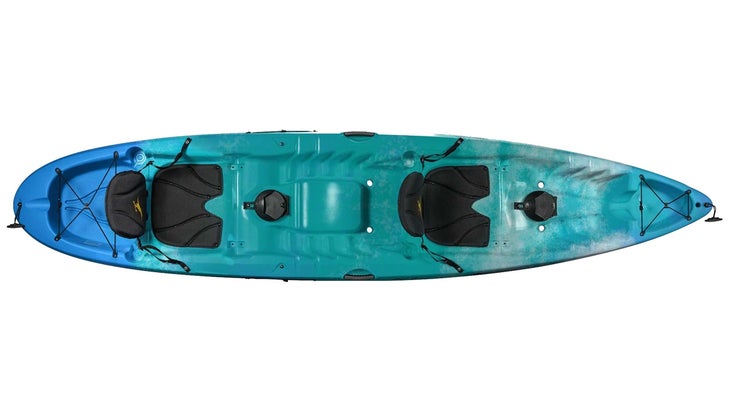
Best Recreational Kayak
Old Town Ocean Kayak Malibu Two XL
$1,200 at Backcountry $1,200 at Amazon
Length: 13 ft
Width: 35 in
Weight: 90 lbs
Pros and Cons
⊕ High weight capacity
⊗ Not for windy conditions
You’ll look at lakes, bays, and easy-flowing rivers in a new light while paddling the Ocean Kayak Malibu Two XL recreational kayak. Perfect for heading out with your kid, spouse, pooch, or friend, it’s the ultimate family machine that can be paddled solo or tandem, with 491 pounds of weight capacity.
Our testers took it throughout the bays and inland waterways of Florida and found it perfect for the Sunshine State and beyond. “Very dry with a well-planned out deck,” said tester Tony Lai of St. Petersburg, who paddled it in wind with a little chop and touted its built-in seats with backrests, storage hatches, cup holders, molded footwells and cooler spot, and front and rear tank wells. “Plenty of space for whatever you want to bring.” He also relished its higher sitting frame seat (an upgrade) and center deck space for fishing. “Super easy to stand up on and get back down,” he said. “A great poling platform for sight fishing.”
Sarasota’s Ryan Nowakowski took it out with his 70-pound son Jackson,10, on a calm bay with an outgoing tide and winds around seven knots. “Roomy, comfortable, stable and versatile,” he said, acknowledging its tracking ability and AirComfort seats, which have an adjustable backrest and position your knees at a natural bend. “Can handle family beach days, lazy bay paddling, and wind, waves and chop. Not for super long distances, but great for shorter jaunts with stability and comfort.”
Testament came when they were drifting in about three feet of water, and out of nowhere the bow beneath Jackson was hit and launched up in the air by a very startled manatee. “Jackson was scared but the kayak didn’t capsize,” he said.
Nowakowski also applauded the waterproof hatches in front of each seat, which are deeper than those on other models and able to carry phones, wallets, keys, and more, as well as improved scupper locations so any water that gets in drains back out quickly. “You can stuff your accessories right in front of you for easy access, which frees up the tank well for coolers or other items,” he says. “Unfortunately, we couldn’t grab our phone quick enough for the manatee.”
Noting it didn’t want to track as well in windy or up current conditions, we wouldn’t recommend the Malibu Two XL for more serious expeditions.
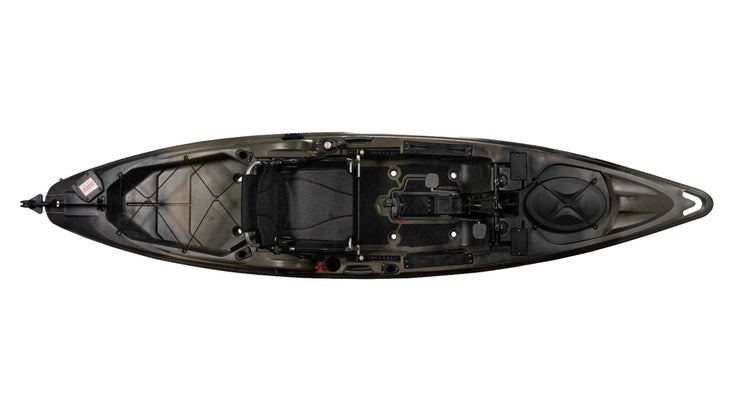
Best Fishing Kayak
Old Town Sportsman BigWater ePDL+ 132
$6,000 at Backcountry $6,000 at Amazon
Length: 13’2”
Width: 36 in
Weight: 143 lbs
Pros and Cons
⊕ E-bike technology makes it easy to go against ocean tides while fishing
⊕ Lifetime hull warranty
⊗ Have to cut off the power to go into reverse, which can waste precious seconds with a fish on the line
The BigWater ePDL+ is Old Town’s most innovative pedal kayak, essentially using what is best described as e-bike technology. In short, its battery-powered pedal-drive lets anglers switch between manual paddle, pedal, power-assist pedal, or fully motorized cruise control, upping the versatility for kayak fishing. The LED screen shows you the mode, speed/assist level, and battery consumption level.
“Very intuitive, not much of a learning curve,” said tester Christi Holmes, who paddled it on lakes and tidal bays in Maine and Florida. “Excelled going against ocean surf and tides when trying to get to my fishing grounds.” She loved that she could take breaks for snacks, photos, and changing lures while the kayak kept cruising. “Liked knowing that if my battery died, I could just pedal back,” she said, adding it was great for trolling and heading against Maine’s powerful tidal rivers. “It works best in tidal areas or areas with strong currents and you need to get somewhere. Less work meant I could go farther and fish longer.”
Tester Bill Sikora used it on the fresh and saltwater of the South Florida canal. “Stable hull and lower speed great for trolling for gamefish and against the tide,” he said, adding that while trolling a small blade bait he hooked into a peacock bass. “I locked the rudder in place and just enjoyed the ride. The drive never felt glitchy and maintained speed even during extended use—and never felt it would die thanks to the power indicator.” The only weakness he noted was that you had to cut the power off to go into reverse. If a hooked fish turns toward a structure on a bank, he said, pedaling backward lets you pull it back out into open water. “With the power-assist engaged, you have to pedal a few times before it kicks off and the drive goes back into manual mode,” he said, which takes up precious seconds when you have a fish on the line.
Other features include a lifetime hull warranty (two years for the ePDL+ drive), a 36-volt lithium-ion battery, EVA foam floor pads for standing, rod and cup holders, a tackle box, full-length accessory tracks for customization, a wide stern tank well, and an offset shallow water anchor mount.
How to Choose a Boat
Generally, there are canoes and sea kayaks for touring lakes and bays, hardshell recreational and inflatable kayaks for user-friendly flatwater paddling (and also inflatable kayaks for Class I-III whitewater), and whitewater rafts and kayaks designed for running rivers. It’s important to decide what kind of paddling you’re most interested in before making any decisions about which boat to buy. Factors should include your proximity to water (and what type of water that is), skill level, and storage access. Below is a quick rundown on the types of crafts you can choose from.
Sit-Inside Kayaks
These are good for folks paddling in cooler climates or taking longer trips, since sitting inside a closed cockpit keeps you drier and more out of the wind. They also offer better in-hull storage for gear, making them better for extended jaunts. Touring models such as sea kayaks are generally longer and narrower, making them faster and better suited for bigger crossings and multi-day trips (most come with a nylon spray skirt to keep splashes at bay). Recreational kayaks cater more to entry-level paddlers and are shorter, wider, and more stable, plus they usually have larger cockpits. The tradeoff is they’re a bit slower and require more effort to paddle long distances.
Sit-on-Top Kayaks
These are touring and recreational kayaks that let you sit outside in a self-draining depression in the hull rather than inside a cockpit. They’re great for entry-level paddlers since you can climb back on if you tip over, and are well-suited for warmer climates. In general, wider means more stable, and longer means faster, even though they’re generally slower than their sit-inside brethren.
Inflatable Kayaks
Let’s call them IKs instead of duckies; it sounds better and is more in line with their performance. As with rafts, abrasion-resistant rubber makes inflatable kayaks well-suited for rivers and other rocky environments. What inflatable kayaks lack in hull speed they make up for in stability, durability, and portability—when you’re through paddling, simply roll them up for transport and storage back at home. Available in both single and double models, most also have inflatable self-bailing floors.
Fishing Kayaks
Fishing kayaks are the same as sit-on-tops, but with options to add accessories such as rod holders, bait platforms, anchors, tackle compartments, electronics, and more. They’re generally wider, heavier, and more stable (some let you cast while standing), with large maximum capacities for gear—and fish. Pedal kayaks are propelled via a removable system that drops through the hull in front of your seat (note: you can also use a paddle). They can reach speeds of five miles per hour (faster than you can paddle) and are steered with a hand-operated rudder. While their origins stem from fishing (i.e. they keep your hands free for casting), they’re becoming popular for general recreational use as well, and are good options for birding, sightseeing, exploring, and other uses. Most also come with a forward and reverse mode, which can be handy for retrieving a snagged lure.
Whitewater Kayaks
Whitewater kayaks run the gamut from tiny playboats built specifically for surfing waves to more bulbous creek boats for charging through hydraulics, to well-rounded river runners, built for easy paddling downstream. Determine what kind of water you’ll be paddling before making your decision. “Half-slice” boats are becoming increasingly popular, with a forgiving bow for river running and a flat stern for playing, squirting, and surfing.
Pack Rafts
This burgeoning category consists of uber-lightweight, bathtub-shaped inflatable rafts that are easy to carry into hard-to-reach lakes and other waterways. They come in a variety of shapes, weights, and sizes, from super light (under four pounds) for easy portaging, to more robust models complete with sprayskirts and thigh straps for whitewater.
Whitewater Rafts
These durable boats are generally made for carrying gear and passengers down whitewater rivers. They range from heavy-duty haulers for multi-day trips to light and fast fishing vessels complete with raised seats and casting platforms.
Other Considerations to Ask Yourself
There are a lot of choices when it comes to design and materials. Ask yourself a few questions to narrow your search to the best craft for your needs, such as:
What kind of paddling do I want to do?
The water conditions will greatly affect the type of boat that is right for you. Will you be sticking to flatwater lakes and rivers or tackling whitewater?
How much space do I need?
For longer day trips and overnights, you’ll need room for extra gear, so consider slightly larger, or even tandem models.
What’s my budget?
There’s a wide range of prices depending on size, design, and material, for everything from rec to whitewater kayaks. Decide how high-performance you want to go and what your budget constraints are before narrowing it down.
Do I want a tandem or single?
Many rec and touring kayaks are made in single- and two-person versions. While it is possible to paddle a tandem kayak solo, it’s more difficult, so only get a tandem kayak if you’ll be using it mostly with someone else.
What type of material should I choose?
As with most things, you get what you pay for. Weight and durability are the big variables to watch for. Some higher-end boats are made of fiberglass and composite, making them lighter but more expensive and less durable. The majority of recreational and whitewater kayaks are made from plastic, which is affordable and durable.
How We Test
- Number of testers: 14
- Number of products tested: 19
- Miles paddled: 136
- Cumulative put-ins reached: 24
- Post-paddle PBRs: 36 (minus the one that exploded)
- Cups of coffee: 25
- Hull bumps by manatees: 1
To test boats this season, we assembled a team of expert paddlers from around the country who took some of the newest paddle craft on the market everywhere from the manatee-filled estuaries of Florida to the Rockies and rivers of Washington. The group consisted of guides, retailers, whitewater junkies, fishing aficionados, and more, all sharing a love for being on the water as often as possible. Overall, we got our feet wet on 19 different tester boats, whittling the list down to the above five based on performance, weight, and durability.
Meet Our Lead Tester
Testing manager Eugene Buchanan is the 14-year publisher and editor-in-chief of Paddler magazine and founder of PaddlingLife.com. He’s written about the outdoors for more than 30 years. He’s a former ski patroller, raft, and kayak guide whose passion for paddling has taken him to more than 30 countries on six continents. A Fellow member of the Explorer’s Club, he was also the recipient of W.L. Gore & Associates’s prestigious Shipton-Tillman grant for a 27-day, white-knuckle whitewater trip down Siberia’s Bashkaus River, a trip he chronicled in one of his five books, Brothers on the Bashkaus.
Source link

